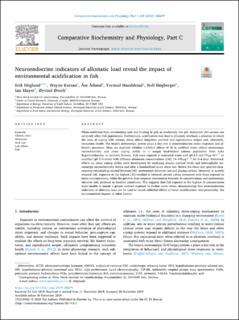| dc.contributor.author | Höglund, Erik | |
| dc.contributor.author | Korzan, Wayne | |
| dc.contributor.author | Åtland, Åse | |
| dc.contributor.author | Haraldstad, Tormod | |
| dc.contributor.author | Høgberget, Rolf | |
| dc.contributor.author | Mayer, Ian | |
| dc.contributor.author | Øverli, Øyvind | |
| dc.date.accessioned | 2021-05-27T11:43:54Z | |
| dc.date.available | 2021-05-27T11:43:54Z | |
| dc.date.created | 2020-09-21T15:40:12Z | |
| dc.date.issued | 2020 | |
| dc.identifier.citation | Comparative Biochemistry and Physiology - Part C: Toxicology & Pharmacology. 2020, 229, 108679. | en_US |
| dc.identifier.issn | 1532-0456 | |
| dc.identifier.uri | https://hdl.handle.net/11250/2756655 | |
| dc.description.abstract | When mobilized from surrounding soils and binding to gills at moderately low pH, aluminum (Al) cations can adversely affect fish populations. Furthermore, acidification may lead to allostatic overload, a situation in which the costs of coping with chronic stress affects long-term survival and reproductive output and, ultimately, ecosystem health. The brain's serotonergic system plays a key role in neuroendocrine stress responses and allostatic processes. Here, we explored whether sublethal effects of Al in acidified water affects serotonergic neurochemistry and stress coping ability in a unique land-locked salmon population from Lake Bygelandsfjorden, in southern Norway. Fish were exposed to untreated water with pH 6.5 and 74 μg Al l−1 or acidified (pH 5.5) water with different aluminum concentrations ([Al]; 74–148 μg l−1) for 5–6 days. Afterward, effects on stress coping ability were investigated by analyzing plasma cortisol levels and telencephalic serotonergic neurochemistry before and after a standardized acute stress test. Before the stress test, positive dose-response relationships existed between [Al], serotonergic turnover rate and plasma cortisol. However, in acutely stressed fish, exposure to the highest [Al] resulted in reduced cortisol values compared with those exposed to lower concentrations, while the positive dose-response relationship between Al concentrations and serotonergic turnover rate persisted in baseline conditions. This suggests that fish exposed to the highest Al concentration were unable to mount a proper cortisol response to further acute stress, demonstrating that neuroendocrine indicators of allostatic load can be used to reveal sublethal effects of water acidification—and potentially, the environmental impacts of other factors. | en_US |
| dc.language.iso | eng | en_US |
| dc.publisher | Elsevier | en_US |
| dc.rights | Navngivelse 4.0 Internasjonal | * |
| dc.rights.uri | http://creativecommons.org/licenses/by/4.0/deed.no | * |
| dc.title | Neuroendocrine indicators of allostatic load reveal the impact of environmental acidification in fish | en_US |
| dc.type | Peer reviewed | en_US |
| dc.type | Journal article | en_US |
| dc.description.version | publishedVersion | en_US |
| dc.rights.holder | © 2020 The Authors | en_US |
| dc.source.pagenumber | 7 | en_US |
| dc.source.volume | 229 | en_US |
| dc.source.journal | Comparative Biochemistry and Physiology - Part C: Toxicology & Pharmacology | en_US |
| dc.identifier.doi | 10.1016/j.cbpc.2019.108679 | |
| dc.identifier.cristin | 1831801 | |
| cristin.ispublished | true | |
| cristin.fulltext | original | |
| cristin.qualitycode | 1 | |

